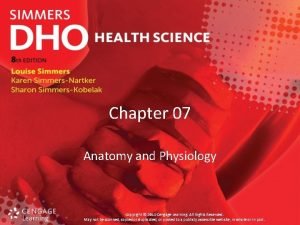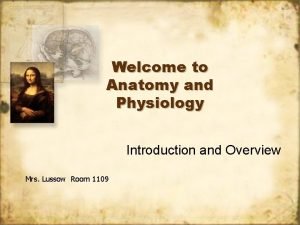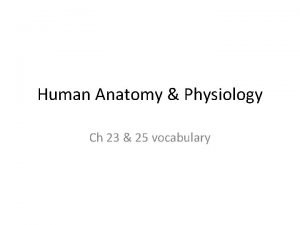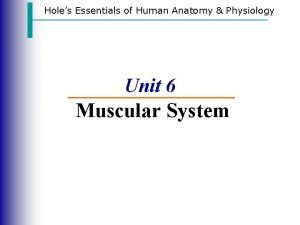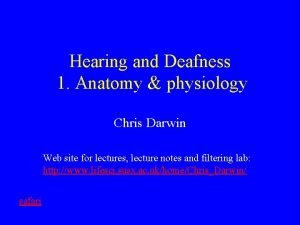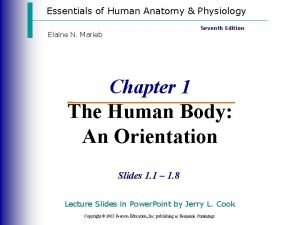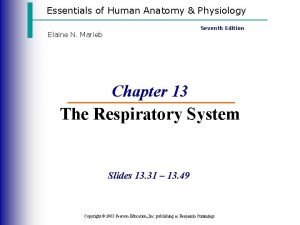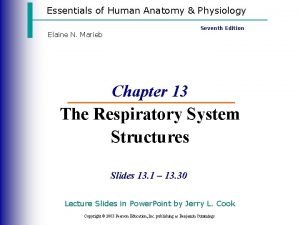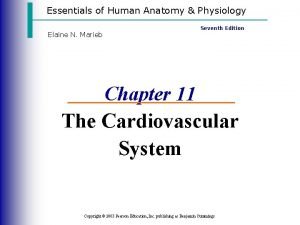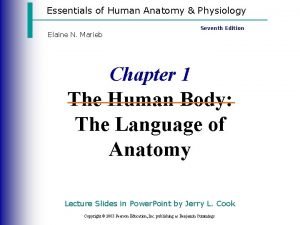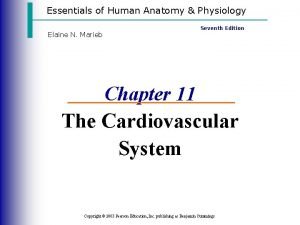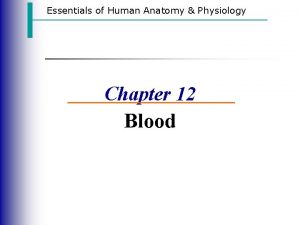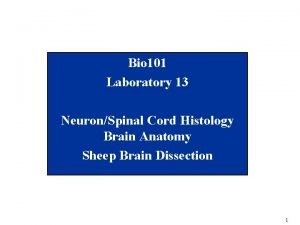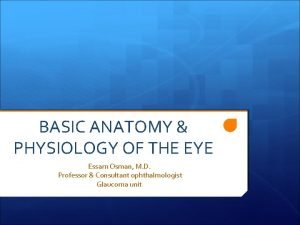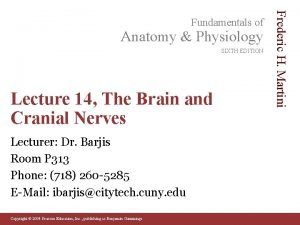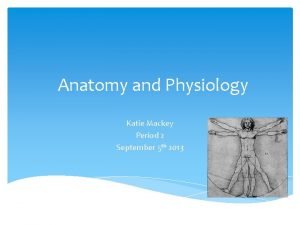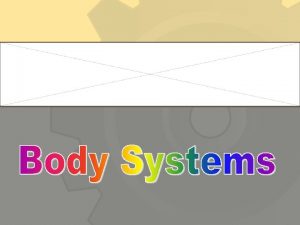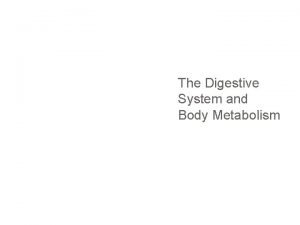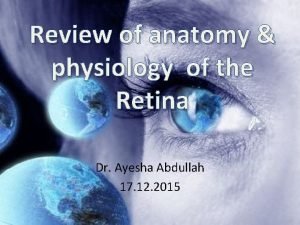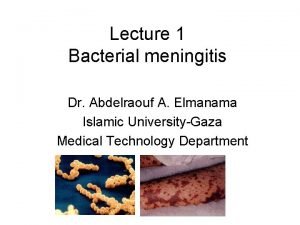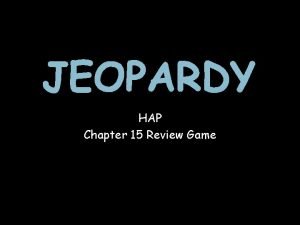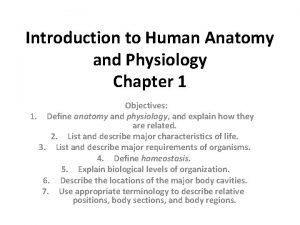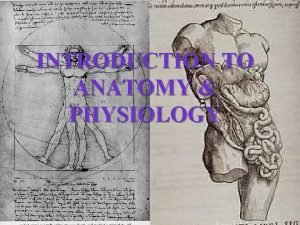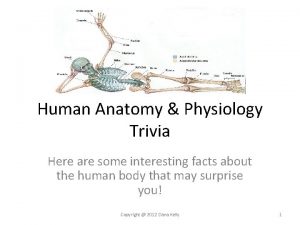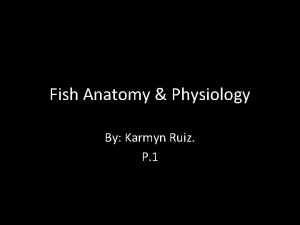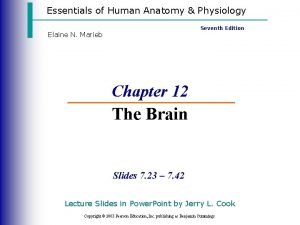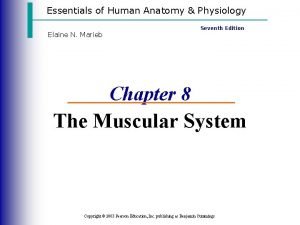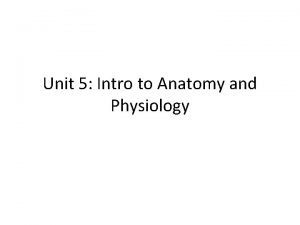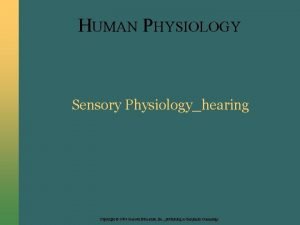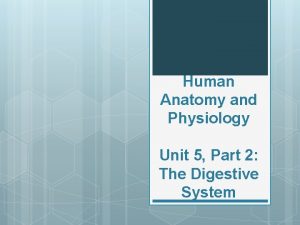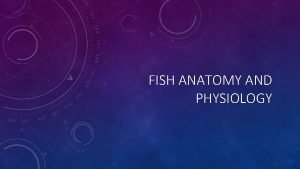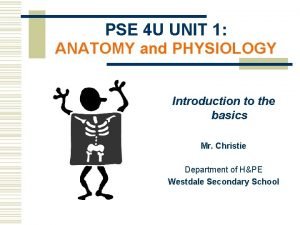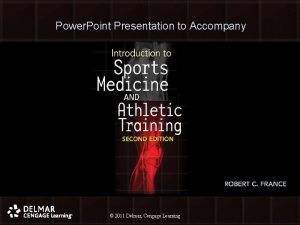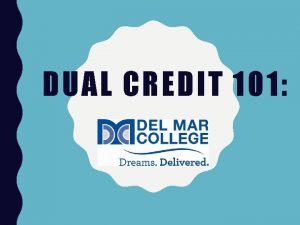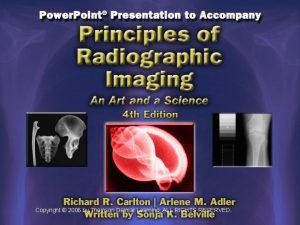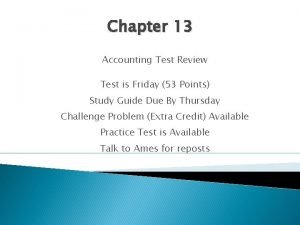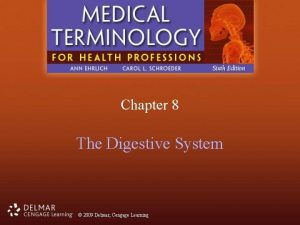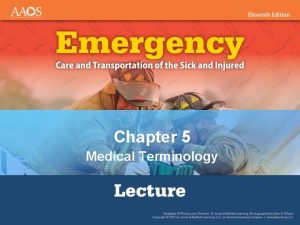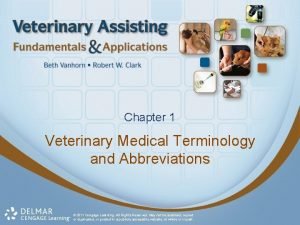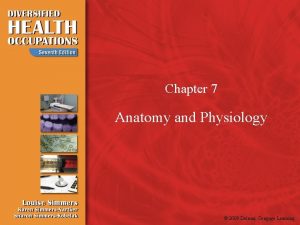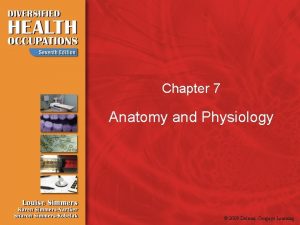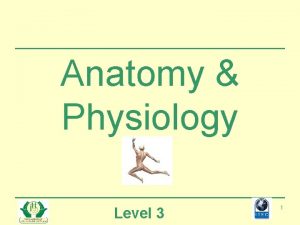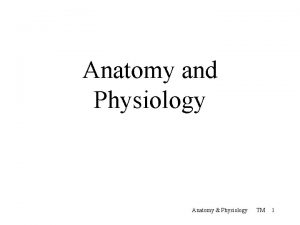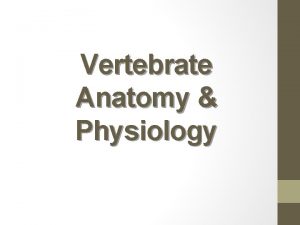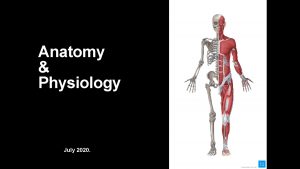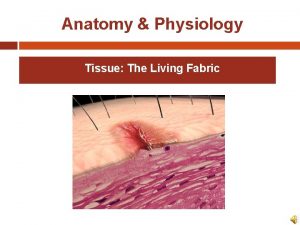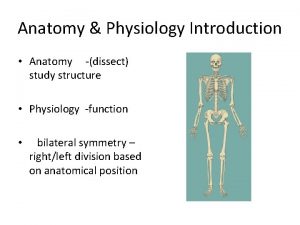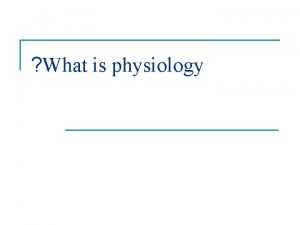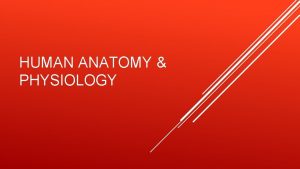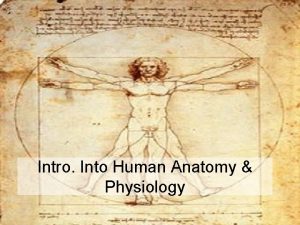Chapter 7 Anatomy and Physiology 2009 Delmar Cengage
































































































































- Slides: 128

Chapter 7 Anatomy and Physiology © 2009 Delmar, Cengage Learning

7: 1 Basic Structure of the Human Body • The normal function of the human body is compared to an organized machine • The machine malfunctions, disease occurs • Anatomy: study of form and structure • Physiology: study of processes • Pathophysiology: study of how disease occurs and body’s response © 2009 Delmar, Cengage Learning

Protoplasm • Basic substance of life • Made of ordinary elements (e. g. , carbon, oxygen, hydrogen) • Scientists can combine these elements, but not create life © 2009 Delmar, Cengage Learning

Cells • • • Made of protoplasm Microscopic organisms Carry on all functions of life Body contains trillions of cells Vary in shape and size Perform different functions © 2009 Delmar, Cengage Learning

Basic Parts of Cells • • Cell membrane Cytoplasm Organelles Nucleus Nucleolus Chromatin Genome (continues) © 2009 Delmar, Cengage Learning

Basic Parts of Cells (continued) • • Centrosome Mitochondria Golgi apparatus Endoplasmic reticulum Vacuoles Lysosomes Pinocytic vesicles © 2009 Delmar, Cengage Learning

Mitosis • Asexual reproduction process used by most cells • Different types of cells reproduce at different rates • Process of mitosis—see Figure 7 -2 in text © 2009 Delmar, Cengage Learning

Meiosis • Process by which sex cells reproduce • Uses two separate cell divisions • Female cells (ova) and male cells (spermatozoa or sperm) divide to produce 23 chromosomes each • When ova and sperm combine, 46 chromosomes result to form zygote © 2009 Delmar, Cengage Learning

Tissues • Cells of same type joined together • 60%– 99% water • Groups of tissues – – Epithelial Connective Nerve Muscle © 2009 Delmar, Cengage Learning

Organs and Systems • Organs: two or more tissues joined together for a specific purpose • Systems: organs and other body parts joined together for a particular function © 2009 Delmar, Cengage Learning

Summary • • • Protoplasm is basic substance of life Protoplasm forms structural units called cells Cells combine to form tissue Tissues combine to form organs Organs and other parts combine to form systems • Systems work together to create miracle of human body © 2009 Delmar, Cengage Learning

7: 2 Body Planes/Directions/Cavities • Body planes: imaginary lines drawn through body at various levels to separate body into sections • Directional terms are created by planes • Transverse plane • Midsagittal or median plane • Frontal or coronal plane • Proximal and distal © 2009 Delmar, Cengage Learning

Cavities • Spaces within the body that contain vital organs • Dorsal or posterior cavity • Ventral or anterior cavities – Thoracic cavity – Abdominal cavity – Pelvic cavity • Three small cavities © 2009 Delmar, Cengage Learning

Abdominal Regions • Abdominal cavity is separated into regions or sections because it is so large • Quadrants – – RUQ LUQ RLQ LLQ (continues) © 2009 Delmar, Cengage Learning

Abdominal Regions (continued) • Regions – – – Epigastric Umbilical Hypogastric Hypochondriac Lumbar Iliac or inguinal © 2009 Delmar, Cengage Learning

7: 3 Integumentary System • Name for the skin and its structures • Called a membrane because it covers the body • Called an organ because it contains several kinds of tissues • Called a system because it has organs and other parts that work together for a particular function © 2009 Delmar, Cengage Learning

Layers of the Skin • Epidermis—outermost layer • Dermis—“true skin” • Subcutaneous fascia or hypodermis— the innermost layer © 2009 Delmar, Cengage Learning

Glands and Other Parts of the Skin • • Sudoriferous glands (sweat glands) Sebaceous glands (oil glands) Hair Nails © 2009 Delmar, Cengage Learning

Functions • • Protection Sensory perception Regulation of body temperature Storage Absorption Excretion Production © 2009 Delmar, Cengage Learning

Skin Color—Pigmentation • Skin color is inherited and is determined by pigments in the epidermis • Melanin • Carotene © 2009 Delmar, Cengage Learning

Skin Color—Albino • • Absence of skin pigments Skin has pinkish tint Hair is pale yellow or white Eyes are red in color and sensitive to light © 2009 Delmar, Cengage Learning

Skin Color—Abnormal • Erythema • Jaundice • Cyanosis © 2009 Delmar, Cengage Learning

Skin Eruptions • • Macules (macular rash) Papules (papular rash) Vesicles Pustules Crusts Wheals Ulcer © 2009 Delmar, Cengage Learning

Diseases and Abnormal Conditions • Acne vulgaris • Athlete’s foot • Skin cancer – Basal cell carcinoma – Squamous cell carcinoma – Melanoma (continues) © 2009 Delmar, Cengage Learning

Diseases and Abnormal Conditions (continued) • • • Dermatitis Eczema Impetigo Psoriasis Ringworm Verrucae/warts/plantar warts © 2009 Delmar, Cengage Learning

7: 4 Skeletal System • Made of organs called bones • Adult has 206 bones • Serves as framework for muscles, fat, and skin • Protects internal structures • Produces blood cells • Stores calcium, phosphorus, and fats © 2009 Delmar, Cengage Learning

Long Bones • • • Bones of the extremities Diaphysis Epiphysis Medullary canal Yellow marrow (continues) © 2009 Delmar, Cengage Learning

Long Bones (continued) • • Endosteum Red marrow Periosteum Articular cartilage © 2009 Delmar, Cengage Learning

Skeleton • Axial – Main trunk of body – Skull, spinal column, ribs, and sternum • Appendicular – Extremities – Shoulder girdle, arm bones, pelvic girdle, and leg bones © 2009 Delmar, Cengage Learning

Skull • • Cranial and facial bones Sutures Sinuses Foramina © 2009 Delmar, Cengage Learning

Cranial Bones • Eight bones of skull that surround and protect the brain • Frontal • Parietal (2) • Temporal (2) • Occipital • Ethmoid • Sphenoid © 2009 Delmar, Cengage Learning

Facial Bones • • 14 bones of skull that form facial features Mandible—lower jaw Maxilla (2)—upper jaw Zygomatic (2)—cheek Nasal (5)—upper part of nose Lacrimal (2)—inner aspect of eye Palatine (2)—hard palate (roof of mouth) © 2009 Delmar, Cengage Learning

Vertebrae • • Spinal column— 26 bones Protects the spinal cord Supports head and trunk Cervical (7)—neck Thoracic (12)—chest, attach to ribs Lumbar (5)—waist Sacrum (1)—back of pelvic girdle Coccyx (1)—tailbone © 2009 Delmar, Cengage Learning

Intervertebral Disks • Pads of cartilage separating vertebrae • Act as shock absorbers • Permit bending and twisting movements © 2009 Delmar, Cengage Learning

Ribs (costae) • • 12 pairs of long slender bones Attach to thoracic vertebrae True ribs—first 7 pairs; attach to sternum False ribs—last 5 pairs © 2009 Delmar, Cengage Learning

Sternum • • Breastbone Consists of 3 parts Two clavicles attach Ribs attach with cartilage © 2009 Delmar, Cengage Learning

Shoulder or Pectoral Girdle • 2 clavicles (collarbones) • 2 scapula (shoulder bones) • Upper arm bones attach to scapula © 2009 Delmar, Cengage Learning

Bones of the Arm • • • Humerus Radius Ulna Carpals Metacarpals Phalanges © 2009 Delmar, Cengage Learning

Bones of Pelvic Girdle • • Consists of 2 os coxae (coxal or hip bones) Symphysis pubis Ilium Ischium Pubis Acetabula Obturator foramen © 2009 Delmar, Cengage Learning

Bones of the Legs • • Femur Patella Tibia Fibula Tarsals Metatarsals Phalanges © 2009 Delmar, Cengage Learning

Joints • Where two or more bones join • Ligaments • Three types of joints – Diarthrosis or synovial – Amphiarthrosis – Synarthrosis © 2009 Delmar, Cengage Learning

Diseases and Abnormal Conditions • • • Arthritis Bursitis Fractures Dislocation Sprain Osteomyelitis (continues) © 2009 Delmar, Cengage Learning

Diseases and Abnormal Conditions (continued) • Osteoporosis • Ruptured disk • Abnormal curvature of spine – Kyphosis – Scoliosis – Lordosis © 2009 Delmar, Cengage Learning

7: 5 Muscular System • 600+ muscles in the body • Bundles of muscle fibers held together with connective tissue • Properties of muscles – – Excitability/irritability Contractibility Extensibility Elasticity © 2009 Delmar, Cengage Learning

Kinds of Muscles • Cardiac—involuntary • Visceral or smooth—involuntary • Skeletal—voluntary © 2009 Delmar, Cengage Learning

Functions of Muscles • • Attach to bones to provide movement Produce heat and energy Help maintain posture Protect internal organs © 2009 Delmar, Cengage Learning

Attachments to Bone • Tendon • Fascia • Origin and insertion © 2009 Delmar, Cengage Learning

Actions or Movements of Muscles • • • Adduction Abduction Flexion Extension Rotation Circumduction © 2009 Delmar, Cengage Learning

Muscle Tone • Partially contracted at all times • Muscle tone allows for state of readiness • Loss of muscle tone © 2009 Delmar, Cengage Learning

Diseases and Abnormal Conditions • • • Fibromyalgia Muscular dystrophy Duchenne’s dystrophy Myasthenia gravis Muscle spasms or cramps Strain © 2009 Delmar, Cengage Learning

7: 6 Nervous System • Complex and highly organized • Coordinates all of the many activities of the body • Allows the body to respond adapt to changes that occur both inside and outside the body © 2009 Delmar, Cengage Learning

Neuron • Neuron is also called a nerve cell • Basic structural unit of the nervous system • Parts of neuron – Cell body – Nucleus – Nerve fibers (dendrites, axon) © 2009 Delmar, Cengage Learning

Nerves • • • Combination of nerve fibers Located outside the brain and spinal cord Afferent—sensory nerves Efferent—motor nerves Associative—internuncial nerves © 2009 Delmar, Cengage Learning

Central Nervous System • Consists of two main divisions – – – Central nervous system (CNS) Brain and spinal cord Peripheral nervous system Somatic nervous system Autonomic nervous system © 2009 Delmar, Cengage Learning

Central Nervous System The Brain • • • Cerebrum Cerebellum Diencephalon Midbrain Pons Medulla oblongata © 2009 Delmar, Cengage Learning

Central Nervous System The Spinal Cord • • Continues down from medulla oblongata Surrounded and protected by the vertebrae Responsible for many reflex actions Carries sensory (afferent) messages to the brain • Carries motor (efferent) message from the brain © 2009 Delmar, Cengage Learning

Central Nervous System • • • Meninges Dura mater Arachnoid membrane Pia mater Ventricles © 2009 Delmar, Cengage Learning

Peripheral Nervous System • Cranial nerves • Spinal nerves • Autonomic nervous system – Sympathetic – Parasympathetic © 2009 Delmar, Cengage Learning

Diseases and Abnormal Conditions • • • Amyotrophic lateral sclerosis (ALS) Carpal tunnel syndrome Cerebral palsy Cerebrovascular accident (CVA) Encephalitis Epilepsy or seizure syndrome (continues) © 2009 Delmar, Cengage Learning

Diseases and Abnormal Conditions (continued) • • Hydrocephalus Meningitis Multiple sclerosis (MS) Neuralgia Paralysis Parkinson’s disease Shingles or herpes zoster © 2009 Delmar, Cengage Learning

7: 7 Special Senses • Senses allow body to react to the environment • See, hear, taste, smell, and to maintain balance • Body structures receive sensation, nerves carry to brain, brain interprets and responds to message © 2009 Delmar, Cengage Learning

Eye • • Sense of sight Light rays transmitted to the optic nerve Optic nerve relays information to brain Eye is well protected – – Bony socket Eyelids and eyelashes Lacrimal glands Conjunctiva © 2009 Delmar, Cengage Learning

Layers of the Eye • Sclera—outer • Choroid coat—middle • Retina—innermost © 2009 Delmar, Cengage Learning

Other Special Structures • • • Iris Pupil Lens Aqueous humor Vitreous humor Muscles © 2009 Delmar, Cengage Learning

Diseases and Abnormal Conditions • • • Amblyopia—lazy eye Astigmatism Cataract Conjuctivitis—pink eye Glaucoma (continues) © 2009 Delmar, Cengage Learning

Diseases and Abnormal Conditions (continued) • • • Hyperopia—farsightedness Myopia—nearsightedness Macular degeneration Presbyopia Strabismus © 2009 Delmar, Cengage Learning

Ear • Controls hearing and balance • Sound waves transmitted to the auditory nerve • Auditory nerve relays information to the brain for interpretation • Consists of the outer ear, middle ear, and inner ear © 2009 Delmar, Cengage Learning

Outer Ear • Pinna or auricle • Auditory canal • Tympanic membrane © 2009 Delmar, Cengage Learning

Middle Ear • • Malleus Incus Stapes Eustachian tube © 2009 Delmar, Cengage Learning

Inner Ear • • • Oval window Vestibule Cochlea Organ of Corti Semicircular canals © 2009 Delmar, Cengage Learning

Diseases and Abnormal Conditions • • • Hearing loss Meniere’s disease Otitis externa Otitis media Otosclerosis © 2009 Delmar, Cengage Learning

Sense of Taste • Taste receptors located on the tongue • Four main tastes – – Sweet Salty Sour Bitter © 2009 Delmar, Cengage Learning

Sense of Smell • Nose is the organ of smell • Olfactory receptors in nasal cavity • Impulses carried from the olfactory nerve to the brain for interpretation • Humans can detect over 6, 000 smells • Sense of taste and smell related © 2009 Delmar, Cengage Learning

Skin and General Senses • Sense receptors for pressure, heat, cold, touch, and pain located in the skin and connective tissue • Allows the human body to respond to its environment • Help body react to conditions that could cause injury © 2009 Delmar, Cengage Learning

7: 8 Circulatory System • Also known as the cardiovascular system • Consists of heart, blood vessels, blood • Transports oxygen and nutrients to all body cells • Transports carbon dioxide and metabolic materials away from the body cells © 2009 Delmar, Cengage Learning

Heart • • Muscular, hollow organ functions as pump Weight is less than one pound Location Three layers of tissue – Endocardium – Myocardium – Pericardium (continues) © 2009 Delmar, Cengage Learning

Heart (continued) • Septum • Heart chambers • Valves – – Tricuspid Pulmonary Mitral Aortic (continues) © 2009 Delmar, Cengage Learning

Heart (continued) • Cardiac cycle • Conductive pathways • Arrhythmias © 2009 Delmar, Cengage Learning

Blood Vessels • Blood is carried throughout the body in blood vessels • Arteries • Capillaries • Veins © 2009 Delmar, Cengage Learning

Blood • • Average adult: 4– 6 quarts Transports many substances Plasma Blood cells – Erythrocytes or red blood cells – Leukocytes or white blood cells – Thrombocytes © 2009 Delmar, Cengage Learning

Diseases and Abnormal Conditions • • • Anemia Aneurysm Arteriosclerosis Atherosclerosis Congestive heart failure (CHF) Embolus (continues) © 2009 Delmar, Cengage Learning

Diseases and Abnormal Conditions (continued) • • • Hemophilia Hypertension Leukemia Myocardial infarction—heart attack Phlebitis Varicose veins © 2009 Delmar, Cengage Learning

7: 9 Lymphatic System • Works with the circulatory system • Removes waste and excess fluids from the body tissues • Lymphatic vessels • Lymph nodes (glands) (continues) © 2009 Delmar, Cengage Learning

Lymphatic System (continued) • • Lymphatic ducts Lymph tissue Spleen Thymus © 2009 Delmar, Cengage Learning

Diseases and Abnormal Conditions • • • Adenitis Hodgkin’s disease Lymphangitis Splenomegaly Tonsillitis © 2009 Delmar, Cengage Learning

7: 10 Respiratory System • Lungs and air passages • Takes oxygen in and removes carbon dioxide • Works continuously or death occurs in 4– 6 minutes (continues) © 2009 Delmar, Cengage Learning

Respiratory System (continued) • • Nose Sinuses Pharynx—throat Larynx—voice box Trachea—windpipe Bronchi Alveoli Lungs © 2009 Delmar, Cengage Learning

Ventilation • • • Process of breathing Inspiration—inhalation Expiration—exhalation External respiration Internal respiration © 2009 Delmar, Cengage Learning

Diseases and Abnormal Conditions • • • Asthma Bronchitis Chronic obstructive pulmonary disease Emphysema Epistaxis—nosebleed (continues) © 2009 Delmar, Cengage Learning

Diseases and Abnormal Conditions (continued) • • • Influenza—flu Laryngitis Lung cancer Pleurisy Pneumonia (continues) © 2009 Delmar, Cengage Learning

Diseases and Abnormal Conditions (continued) • • • Rhinitis Sinusitis Sleep apnea Tuberculosis (TB) Upper respiratory infection (URI) © 2009 Delmar, Cengage Learning

7: 11 Digestive System • Physical and chemical breakdown of food for use by the body • System consists of the alimentary canal and the accessory organs © 2009 Delmar, Cengage Learning

Alimentary Canal • Long muscular tube • Begins at the mouth and ends at the anus • Accessory organs: salivary glands, tongue, teeth, liver, gallbladder, pancreas © 2009 Delmar, Cengage Learning

Mouth, Buccal, or Oral Cavity • • Receives food as it enters the body Actions in the mouth Teeth Tongue Hard palate Soft palate Salivary glands © 2009 Delmar, Cengage Learning

Pharynx or Throat • Carrier for both air and food • Carries food bolus to the esophagus • When bolus swallowed, epiglottis closes to prevent food from entering respiratory tract © 2009 Delmar, Cengage Learning

Esophagus • Muscular tube dorsal to the trachea • Carries bolus to stomach • Peristalsis moves food toward stomach © 2009 Delmar, Cengage Learning

Stomach • • • Receives food from esophagus Mucous membrane lining contains rugae Cardiac sphincter Pyloric sphincter Food remains in stomach about 1– 4 hours Gastric juices © 2009 Delmar, Cengage Learning

Small Intestine • About 20 feet long; 1 inch in diameter • Receives food from the stomach in the form of chyme • Small intestine – Duodenum – Jejunum – Ileum (continues) © 2009 Delmar, Cengage Learning

Small Intestine (continued) • • • Intestinal juices Bile Pancreatic juice Villi When food has finished its journey through the small intestine, only wastes, indigestible materials, and excess water remain © 2009 Delmar, Cengage Learning

Large Intestine • • • About 5 feet long; 2 inches in diameter Functions Cecum Colon Rectum © 2009 Delmar, Cengage Learning

Liver • • Largest gland in the body Accessory organ for digestive system Location Functions © 2009 Delmar, Cengage Learning

Gallbladder • • Small muscular sac Location Stores and concentrates bile Bile needed to emulsify fats © 2009 Delmar, Cengage Learning

Pancreas • Fish-shaped organ located behind the stomach • Produces pancreatic juices to digest food • Produces insulin which is secreted into the blood stream; regulates burning of carbohydrates to convert glucose to energy © 2009 Delmar, Cengage Learning

Diseases and Abnormal Conditions • • Appendicitis Cholecystitis Cirrhosis Constipation Diarrhea Diverticulitis Gastroenteritis (continues) © 2009 Delmar, Cengage Learning

Diseases and Abnormal Conditions (continued) • • Hemorrhoids Hepatitis Hernia or rupture Pancreatitis Peritonitis Ulcerative colitis © 2009 Delmar, Cengage Learning

7: 12 Urinary System • Excretory system • Removes certain wastes and excess water from the body • Maintains homeostasis • Maintains acid-base balance • 2 kidneys, 2 ureters, bladder, and urethra © 2009 Delmar, Cengage Learning

Kidneys • • Bean-shaped organs Location Protection Cortex Medulla Hilum Nephrons © 2009 Delmar, Cengage Learning

Ureters • Muscular tubes about 10– 12 inches long • Extend from renal pelvis of each kidney to bladder • Peristalsis moves urine through tube to bladder © 2009 Delmar, Cengage Learning

Bladder • • • Muscular sac Lined with mucous membranes Three layers of visceral muscle form walls Function Urge to void Circular sphincter muscles © 2009 Delmar, Cengage Learning

Urethra • • • Carries urine from bladder to the outside Urinary meatus Female and male systems Urine Conditions affecting urination © 2009 Delmar, Cengage Learning

Diseases and Abnormal Conditions • • Cystitis Glomerulonephritis or nephritis Pyelonephritis Renal calculus or urinary calculus Renal failure Chronic renal failure Uremia Urethritis © 2009 Delmar, Cengage Learning

7: 13 Endocrine System • Group of ductless (without tubes) glands • Secrete substances called hormones • Hormones that are secreted directly into bloodstream © 2009 Delmar, Cengage Learning

Pituitary Gland • • Master gland of the body Located at the base of the brain Anterior and posterior lobes Acromegaly Giantism Diabetes insipidus Dwarfism © 2009 Delmar, Cengage Learning

Thyroid Gland • • Regulates body’s metabolism Located in neck Requires iodine from food intake Goiter Hyperthyroidism Graves’ disease Hypothyroidism © 2009 Delmar, Cengage Learning

Parathyroid Glands • • Attached to thyroid glands Regulate amount of calcium in the blood Hyperparathyroidism Hypoparathyroidism © 2009 Delmar, Cengage Learning

Adrenal Glands • • • Located above the kidneys Cortex Medulla Addison’s disease Cushing’s syndrome © 2009 Delmar, Cengage Learning

Pancreas • Located behind the stomach • Both an exocrine and endocrine gland • Diabetes mellitus © 2009 Delmar, Cengage Learning

Other Endocrine Glands • Ovaries: female sex glands, located in the pelvis, secrete hormones that regulate menstruation and secondary sexual characteristics • Testes: male sex glands, located in the scrotal sac, produce hormones that regulate secondary sexual characteristics © 2009 Delmar, Cengage Learning

Thymus • • Located in the upper part of chest Active in early life Atrophies (wastes away) during puberty Produces thymosin © 2009 Delmar, Cengage Learning

Pineal Body • Located in the brain • Exact function unknown © 2009 Delmar, Cengage Learning

Placenta • Temporary endocrine gland produced during pregnancy • Functions • Expelled after the birth of the child © 2009 Delmar, Cengage Learning

7: 14 Reproductive System • Function is to produce life • Consists of gonads (sex glands) and accessory organs © 2009 Delmar, Cengage Learning

Male Reproductive System • • • Testes Scrotum Epididymis Vas deferens Seminal vesicles Ejaculatory ducts (continues) © 2009 Delmar, Cengage Learning

Male Reproductive System (continued) • • Prostate gland Cowper’s glands Urethra Penis © 2009 Delmar, Cengage Learning

Diseases and Abnormal Conditions Male • • Epididymitis Orchitis Prostatic hypertrophy or hyperplasia Testicular cancer © 2009 Delmar, Cengage Learning

Female Reproductive System • • Ovaries Fallopian tubes Uterus Vagina Bartholin’s glands Vulva Breasts or mammary glands © 2009 Delmar, Cengage Learning

Diseases and Abnormal Conditions Female • • • Breast tumors Cancer of the cervix and/or uterus Endometriosis Ovarian cancer Pelvic inflammatory disease (PID) Premenstrual syndrome (PMS) © 2009 Delmar, Cengage Learning

Sexually Transmitted Diseases (STDs) • • AIDS Chlamydia Gonorrhea Herpes Pubic lice Syphilis Trichomonas vaginalis © 2009 Delmar, Cengage Learning
 Delmar cengage learning medical terminology
Delmar cengage learning medical terminology 2009 delmar cengage learning
2009 delmar cengage learning 1/52 medical terminology
1/52 medical terminology 2009 delmar cengage learning
2009 delmar cengage learning 2009 delmar cengage learning
2009 delmar cengage learning Chapter 13 medical math
Chapter 13 medical math Chapter 10 cultural diversity
Chapter 10 cultural diversity Cengage anatomy and physiology
Cengage anatomy and physiology Delmar cengage learning instructor resources
Delmar cengage learning instructor resources Chapter 14 anatomy and physiology
Chapter 14 anatomy and physiology Chapter 1 introduction to human anatomy and physiology
Chapter 1 introduction to human anatomy and physiology Anatomy and physiology chapter 8 special senses
Anatomy and physiology chapter 8 special senses Chapter 13 anatomy and physiology of pregnancy
Chapter 13 anatomy and physiology of pregnancy Anatomy and physiology chapter 2
Anatomy and physiology chapter 2 Chapter 7 anatomy and physiology
Chapter 7 anatomy and physiology Art labeling activity: figure 14.1 (3 of 3)
Art labeling activity: figure 14.1 (3 of 3) Chapter 10 blood anatomy and physiology
Chapter 10 blood anatomy and physiology Anatomy and physiology chapter 15
Anatomy and physiology chapter 15 Necessary life functions anatomy and physiology
Necessary life functions anatomy and physiology Holes anatomy and physiology chapter 1
Holes anatomy and physiology chapter 1 Anatomy and physiology chapter 15
Anatomy and physiology chapter 15 Distal and proximal
Distal and proximal Chapter 2 human reproductive anatomy and physiology
Chapter 2 human reproductive anatomy and physiology Appendicular skeleton pectoral girdle
Appendicular skeleton pectoral girdle Chapter 6 general anatomy and physiology
Chapter 6 general anatomy and physiology Chapter 1 an introduction to anatomy and physiology
Chapter 1 an introduction to anatomy and physiology Upper respiratory tract
Upper respiratory tract Tattoo anatomy and physiology
Tattoo anatomy and physiology Anatomy science olympiad
Anatomy science olympiad Crown plants examples
Crown plants examples Bone metabolism
Bone metabolism Anatomy and physiology of peptic ulcer
Anatomy and physiology of peptic ulcer Liver anatomy and physiology
Liver anatomy and physiology Hypogastric region
Hypogastric region Epigastric region
Epigastric region The blood anatomy and physiology
The blood anatomy and physiology 3 layers of muscle
3 layers of muscle Http://anatomy and physiology
Http://anatomy and physiology Appendectomy anatomy and physiology
Appendectomy anatomy and physiology Aohs foundations of anatomy and physiology 1
Aohs foundations of anatomy and physiology 1 Aohs foundations of anatomy and physiology 1
Aohs foundations of anatomy and physiology 1 Anatomy and physiology of swine
Anatomy and physiology of swine Unit 26 agriscience
Unit 26 agriscience Science olympiad anatomy and physiology 2020 cheat sheet
Science olympiad anatomy and physiology 2020 cheat sheet Physiology of stomach ppt
Physiology of stomach ppt Pancreas anatomy and physiology
Pancreas anatomy and physiology Aohs foundations of anatomy and physiology 1
Aohs foundations of anatomy and physiology 1 Aohs foundations of anatomy and physiology 1
Aohs foundations of anatomy and physiology 1 Anatomy and physiology
Anatomy and physiology Cornell notes for anatomy and physiology
Cornell notes for anatomy and physiology Human anatomy & physiology edition 9
Human anatomy & physiology edition 9 Holes essential of human anatomy and physiology
Holes essential of human anatomy and physiology Anatomy and physiology unit 7 cardiovascular system
Anatomy and physiology unit 7 cardiovascular system Anatomy and physiology
Anatomy and physiology Aohs foundations of anatomy and physiology 1
Aohs foundations of anatomy and physiology 1 Aohs foundations of anatomy and physiology 1
Aohs foundations of anatomy and physiology 1 Human physiology exam 1
Human physiology exam 1 Welcome to anatomy and physiology
Welcome to anatomy and physiology Physiology of the foot and ankle
Physiology of the foot and ankle Integumentary system psoriasis
Integumentary system psoriasis Pancreas anatomy and physiology
Pancreas anatomy and physiology Anatomy and physiology vocabulary
Anatomy and physiology vocabulary Anatomy and physiology
Anatomy and physiology Biceps muscle names
Biceps muscle names Anatomy and physiology
Anatomy and physiology Body landmarks diagram
Body landmarks diagram Anatomy and physiology
Anatomy and physiology Anatomy and physiology
Anatomy and physiology Anatomy and physiology
Anatomy and physiology Anatomy and physiology
Anatomy and physiology Figure 11-8 arteries
Figure 11-8 arteries Anatomy and physiology
Anatomy and physiology Anatomy and physiology
Anatomy and physiology Anatomy and physiology
Anatomy and physiology Human anatomy and physiology 10th edition
Human anatomy and physiology 10th edition Brain histology labeled
Brain histology labeled Anatomy and physiology of the eye
Anatomy and physiology of the eye Principles of anatomy and physiology tortora
Principles of anatomy and physiology tortora Irn.org anatomy and physiology
Irn.org anatomy and physiology Anatomy and physiology body parts
Anatomy and physiology body parts Unit 26 animal anatomy physiology and nutrition
Unit 26 animal anatomy physiology and nutrition Figure 14-1 digestive system
Figure 14-1 digestive system Anatomy and physiology of the retina
Anatomy and physiology of the retina Mucous connective tissue
Mucous connective tissue Anatomy and physiology of meningitis ppt
Anatomy and physiology of meningitis ppt Jeopardy anatomy and physiology game
Jeopardy anatomy and physiology game What is homeostasis
What is homeostasis Anatomy and physiology
Anatomy and physiology Respiration
Respiration Anatomy and physiology trivia
Anatomy and physiology trivia Superior mouth fish
Superior mouth fish Brain anatomy and physiology
Brain anatomy and physiology Anatomy and physiology
Anatomy and physiology Horizontal anatomical plane
Horizontal anatomical plane 2012 pearson education inc anatomy and physiology
2012 pearson education inc anatomy and physiology Layers of esophagus
Layers of esophagus Fish anatomy and physiology
Fish anatomy and physiology Pse4u
Pse4u Delmar isotonic
Delmar isotonic Delmar tsi
Delmar tsi Delmar customs broker windsor
Delmar customs broker windsor Delmar thomson learning
Delmar thomson learning Borgify
Borgify Chapter 7:10 respitory system
Chapter 7:10 respitory system Cengage chapter 7
Cengage chapter 7 Accounting chapter 13 study guide
Accounting chapter 13 study guide Copyright cengage learning. powered by cognero
Copyright cengage learning. powered by cognero Cengage learning heart diagram
Cengage learning heart diagram Chapter 8 the digestive system labeling exercises
Chapter 8 the digestive system labeling exercises Knowledge of medical terminology
Knowledge of medical terminology Matching muscle directions and positions
Matching muscle directions and positions Cengage medical terminology chapter 1
Cengage medical terminology chapter 1 Geometric sequence function
Geometric sequence function Kramer formulasi
Kramer formulasi Cengage differential equations
Cengage differential equations Bank reconciliation cengage
Bank reconciliation cengage Separation of variables differential equations
Separation of variables differential equations Cengage learning heart diagram
Cengage learning heart diagram Cengage
Cengage Cengage
Cengage Cengage
Cengage South-western cengage learning
South-western cengage learning Cengage
Cengage Cengage
Cengage Cengage
Cengage Cengage learning heart diagram
Cengage learning heart diagram Cengage learning australia
Cengage learning australia Whille
Whille Cengage learning
Cengage learning







